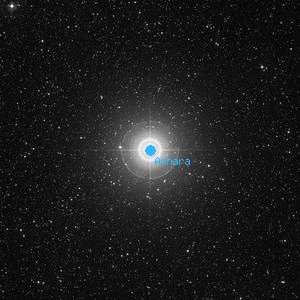Adhara

Overlaid DSS image of Adhara, 60' x 60' with north at top and west to the right
Aladin viewer for the region around Adhara
Epsilon Canis Majoris, ε CMa, 21 CMa
CD-28 3666, HD 52089, HR 2618, WDS J06586-2858, SAO 172676, GSC 06535-03619, HIP 33579
CD-28 3666, HD 52089, HR 2618, WDS J06586-2858, SAO 172676, GSC 06535-03619, HIP 33579
| Type | Star |
|---|---|
| Magnitude | 1.5 | Right Ascension | 6h 58' 37.4" (2000) |
| Declination | 28° 58' 20" S |
| Constellation | Canis Major |
| Classification | B1.5II |
Observing Notes
Andrew Cooper
Feb 25, 2020 Waikoloa, HI (map)
20cm f/6 Newtonian, Cave Astrola @ 61x
Seeing: 7 Transparency: 7 Moon: 0%
Brilliant blue-white, the faint 7.5 magnitude at 8" companion not seen, rich galactic starfield
Captain William Henry Smyth
Oct 30, 1834 No. 6 The Crescent, Bedford, England (map)
150mm f/17.6 refractor by Tully 1827
A Greenwich star with a distant companion, on the Greater Dog's belly: it will be readily found by running a line from the middle of Orion's belt through β, the bright star to the west of Sirius, and extending the same 14° further into the south-east quarter. A 2½, pale orange; B 7, violet, with no appearance of the suspected nearer comes. My meridian observations afford no confirmation of the proper motion assigned by Piazzi, on comparing his results with those of Bradley and La Caille: but Mr. Baily's recent investigation shows a discrepancy with precessional law, although the direction is shaken; the assigned values being:P.... RA -0".05 Dec. +0".07This star is called Adara, from al 'adhára, the virgins; ο, η, δ, and ε, on the shoulder, tail, and between the tail and legs. Adjacent to these Royer cut away a portion of Canis Major, and constructed Columba Noachi therewith in 1679. The part thus usurped was called Muliphein, from al-muhlefeïn, the two stars sworn by, because they were often mistaken for Soheïl, or Canopus, before which they rise: these two stars are now α and β Columbæ. Muliphein is recognised as comprehending the two stars called Hadár, ground, and al-wezn, weight, astonishing sidereal names, says Ideler, of which the Arabians were ignorant of the proper location, for while some placed them to the two bright stars in the Dove, others stuck them in the fore-foot of the Centaur, and a third party assigned them to ζ, λ, and γ, in Argo. Four of the Greater Dog's informes are termed El-Kurûd, the apes, by Kazwíní, which term applies principally to those which Ptolemy described as standing in a line; but 'Abd-u-rahmán Sufi calls them el-furûd, bright and insulated. See δ Canis Majoris, No. CCLXXVIII. The galley rhymes allude to Royers robbery—
B.... -0".06 +0".01
[Hipparcos +0".00324 +0".00133]Where Canis Major, from the south, th' horizon moves above—
The stars that deck'd his hinder feet now form the Patriarch's Dove.― A Cycle of Celestial Objects Vol II, The Bedford Catalogue, William Henry Smyth, 1844
Other Data Sources for Adhara
Nearby objects for Adhara
4 objects found within 120'
| IC 456 | Nganurganity | |
| Ru150 |
Credits...
Drawings, descriptions, and CCD photos are copyright Andrew Cooper unless otherwise noted, no usage without permission.
A complete list of credits and sources can be found on the about page
Adhara